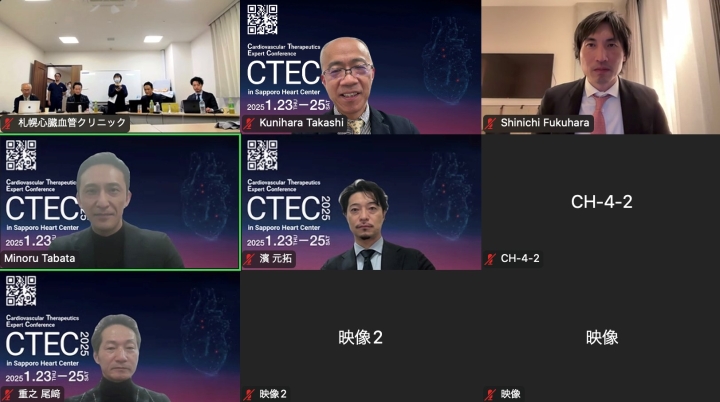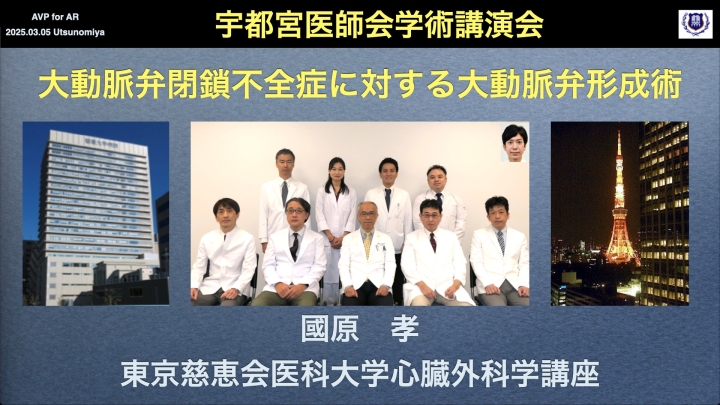大動脈弁形成術を施行致しました
札幌の某病院において大動脈弁形成術を施行し、無事うまくいきました。
中央は華岡青洲直筆の書です。
2025.2.19

若年者の大動脈弁閉鎖不全症に対する大動脈弁形成術について講演しました
2025.2.19

朔先生の症例報告が The Annulus of Thoracic Surgeryに掲載されました
"Successful Repair of a Forme Fruste Bicuspid Aortic Valve by the Raphe Suspension Technique"
Saku K, Arimura S, Kunihara T. et.al Ann Thorac Surg. 2022 Aug;114:e117-e119.
https://www.sciencedirect.com/science/article/pii/S0003497521020968?via=ihub
不完全型の大動脈二尖弁に対し、不全交連の吊り上げが弁形成に有効であった症例の報告です。
不完全型二尖弁は形成手技が確立されておりませんが、この方法が選択肢の一つとなるかもしれません。

EACTS Aoric Valve repair Summitにて有村が演題発表しました_2019年
Moderators: R de Paulis, Rome; Y d’Udekem, Melbourne
Should Patients with Severe Left Ventricular Dysfunction due to Aortic Regurgitation be Contraindicated for Aortic Valve Repair?
S. Arimura T. Kunihara

第180回 日本胸部外科学会関東甲信越地方会にて中尾が演題発表しました_2019年6月8日(土)

第8回圏央Heart Disease Forumにて國原が講演しました
9月20日川越市ラ・ボア・ラクテにて開催された第8回圏央Heart Disease Forumで國原が講演を務めました。
特別講演II 19:45~20:30
「乳頭筋を活かした僧帽弁手術」
演者 國原 孝
座長 中嶋 博之 先生
埼玉医科大学国際医療センター 心臓血管外科 教授


7月23日國原が講演を務めました。
7月23日千葉市において開催された第346回心電図を読む会 学術講演会において國原が特別講演を務めました。
「高齢者に対する心臓血管外科治療は恐くない?」
東京慈恵会医科大学 心臓外科 主任教授 國原 孝
座長:千葉ハートクリニック 院長 今牧 瑞浦 先生
第30回Atago Cardiac Joint Conferenceにおいて國原が講演を務めました。
「大動脈弁って形成できるの?ー心臓血管外科の最前線ー」

第23回日本Advanced Heart & Vascular Surgery/OPCAB研究会にお
7月14日
教育講演演者:「自己弁温存大動脈基部置換術・remodeling」
講演(指定討論者):「自己心膜弁形成術」(尾崎重之教授)
ウェットラボ講師:「remodeling」

[wetlab] Yacoub手術、PVR、Cone手術 を開催しました_7月12日
7月12日13時〜16時 慈恵医大2号館901会議室でYacoub手術、PVR、Cone手術のwet labo、AVSD手術のdry laboを開催しました。
参加者:森田紀代造 宇野吉雅 中尾充貴 木南寛造
参加協力:エチコン
2018年6月28日wet ラボ
MAZE手術、CABG、僧帽弁手術
第117回日本胸部外科学会関東甲信越地方会
アフタヌーンティーセミナー3 胸部大動脈瘤の治療選択の変遷
演者 坂口 元一
第61回関西胸部外科学会学術集会
パネルディスカッション5 二尖弁ARに対する弁形成術
Keynote Lecture 二尖弁ARに対する弁形成術のtips and pitfalls

第8回Cardiology meeting
「心研より慈恵へ ー心臓血管外科の最前線ー」

EACTS Aortic Valve Repair Summit
-Better seeing is more securing- Usefulness of the aortoscopy for aortic valve repair

The 12th International Joint meeting
デュッセルドルフで開催された The 12th International Joint meeting on Cardiovascular Diseases --Meet the Exparts Symposium-- June 7th-9th 2018 において座長および口演をしました。
Friday 8th June 2018 (day 1)
Session 3 (13:00-14:30): Aortic Disease and Valve Repair Äb0
Moderators: Takashi Kunihara (Tokyo); Jeng Wei (Taipei); Artur Lichtenberg (Düsseldorf)
「Aortic root reconstruction and valve repair – from patient profile and therapy planning to optimal long-term results 」

第82回 日本循環器学会 学術集会
Session: Meet the ESC in Japan :Aortic Valve disease
[Aortic Regurgitaion - Threshold & Surgical Intervention-]
Abstract
In the era of aortic valvuloplasty (AVP), threshold for surgical intervention for aortic regurgitation (AR) can be classified into the following three stages:
1) Indication for aortic valve surgeryLeft ventricular end-diastolic/systolic diameter of 65/50mm and left ventricular ejection fraction of 50% is currently defined as threshold for intervention. However, in contrast to aortic valve replacement for cases with aortic stenosis, early surgical outcomes for AR are excellent. With improving long-term results of AVP, we hope earlier intervention will be recommended for low risk patients in the future when AVP is aimed. Early indication will also facilitate AVP.
2) Indication for AVP Currently, most etiologies of AR can be repaired, however, type III lesion is the most challenging case. Cusp height less than 16mm in tricuspid valve and less than 19mm in bicuspid valve is considered as contraindication for AVP. Of course they can be repaired by cusp-extension with a pericardial patch, although the long-term outcomes are still encouraging. Decision-making should be based on negotiation with each case.
3) Indication for root replacementCurrent guidelines recommend aortic root replacement in cases with root diameter more than 45mm when AVP is performed. However, root replacement has another role to facilitate AVP with respect to arrangement of commissural orientation in addition to the prevention of rupture or dissection. Especially in cases with bicuspid aortic valve, this threshold should be lowered. Considering the valve-related adverse events, AVP has an important role in surgical repair of AR.
We believe earlier indication may improve the quality of life of patients with AR necessitating surgical intervention.
第48回心臓血管外科学会 学術総会
三重県で開催された第48回心臓血管外科学会で下記講演を行いました。
有村 ・Aortic root remodeling 手術後のannular distensibilityの変化
松濱 ・大動脈弁形成術における内視鏡的評価の有用性
國原 ・Aortic root remodelingの標準化
・術後血行動態よりみた大動脈弁閉鎖不全症に対する弁形成術の妥当性
第12回東京ハートラボ 「大動脈弁疾患」
2017/11/25
[wet lab] 大動脈弁形成術 参加者17名
2017/11/26
[video live] 大動脈弁形成術は弁置換術を超えたか?
wetlab remodeling+annuloplasty
國原が wetlab 「remodeling+annuloplasty」で実技指導を行いました。
参加者 16名。
第70回 日本胸部外科学会 定期学術総会
札幌で開催された第70回 日本胸部外科学会 定期学術総会において國原が発表しました。
第6回西湘心臓血管病セミナー
國原が「大動脈弁形成術の最前線」と題して講演を行いました。
第245回 日本循環器学会関東甲信越地方会
日本循環器学会 関東甲信越地方会において有村が
「弁尖石灰化を伴う大動脈二尖弁に対し自己心膜パッチ形成とremodeling法を施行した一例」
の症例報告をいたしました。
弁尖に石灰化を伴った大動脈弁では、弁形成は困難とされています。
しかし、本症例では石灰化が弁尖の一部であったため、石灰化を除去し、自己心膜で補填することによって弁形成を行いました。
自己心膜の耐久性・長期成績は得られておりませんが、症例によっては今回の方法は弁形成法の一つとなり得ると考えております。
Kanagawa Cardiologic DIC seminar
第110回日本循環器学会中国・四国合同地方会(高知)
高知県で開催された、第110回日本循環器学会 中国四国合同地方会の教育セッションにて、國原が講演を行いました。
「大動脈弁形成術の適応と手技」
Aortic valve repair summit in Ottawa
オタワ(カナダ)で開催されたAortic valve repair summitで國原が口演を行いました。
「Lessens learned from Japanese registry of valve-preserving root replacement」
~日本のAortic valve academyのレジストリーの集計結果を発表~
第81回日本循環器学会学術集会
2017/3/26
金沢で開催された第81回日本循環器学会で國原が当院での研究成果を発表しました。
「Impact of Aortic Valvuloplasty for Aortic Regurgitation with regard to LV Reverse Remodeling and Transvalvular Hemodynamics」
第9回厚木心臓・血圧研究会
第9回厚木心臓・血圧研究会において、國原が厚木周辺の循環器内科医、心臓血管外科医に対して下記講演を行いました。
「大動脈弁形成術の最前線 -心不全回避を目指して-」
第47回心臓血管外科学会
関 「急性A型大動脈解離におけるAortic root remodeling. 当院における12例の検討」
國原 「大動脈基部再建を念頭に置いた大動脈基部解剖」 (卒後教育セミナー)
「LV reverse remodelingよりみた大動脈弁閉鎖不全症に対する弁形成術の意義」























